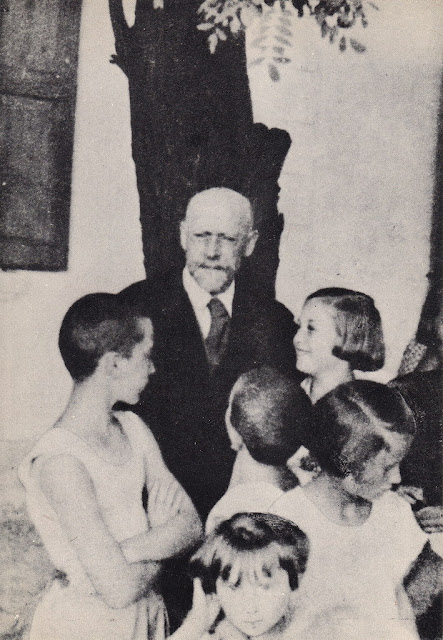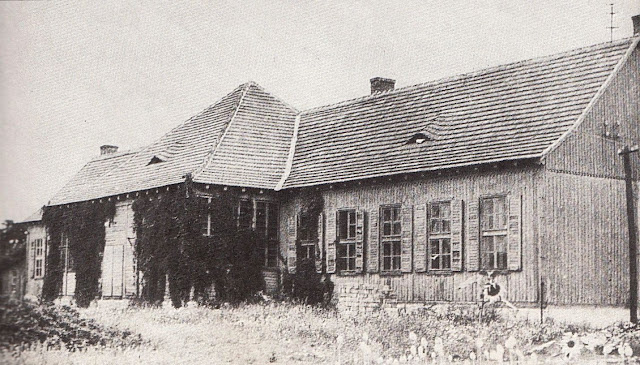Witnesses saw him marching forward with a young child's wrist in his hand, followed by the entire phalanx of his beloved orphans, dressed in their best costumes as if for an outing in the countryside.
Photo by Adrian Grycuk - Own work, CC BY-SA 3.0 pl, https://commons.wikimedia.org/w/index.php?curid=62908535
Overview
Henryk Goldszmit was a world-famous Polish-Jewish author of more than 20 children’s books, a renowned teacher and educator whose reputation was known throughout Europe and beyond. He was often called Pan Doktor (Mr. Doctor) or Stary Doktor (Old Doctor).
Yad Vashem in Israel is the famous memorial to holocaust victims and one is overwhelmed by the multitude of people from different parts of the world the Nazis gathered and killed mercilessly. There is a connection with this memorial with Henryk, a man from Poland.
Henryk with his loved children
Henryk's Belief
Henryk was an extraordinarily gifted man. A scholar and writer, he was also a doctor and a human rights activist, especially an ardent children's rights advocate. In fact, children represented the very core of his passion. Though he went on to write more than twenty books and a thousand articles, his very first book questioned the way most parents rear their children.
At a time when corporal punishment was acceptable for parents to inflict upon disobedient children, Korczak’s 1925 masterpiece, “The Child’s Right to Respect”, was published, read in many countries in translation from the original Polish, and for this unique book Janusz Korczak was awarded a literary prize.
He believed, for instance, that for a father to foist his religion on his child, instead of letting him or her faith later when he or she turns an adult, was nothing short of ruinous brainwashing.
He studied medicine and became a pedestrian in a children's hospital in Warsaw. At the same time he wrote for several Polish publications and gained a literary reputation for his adopted pen name Janusz Korczak. For a while he served as a military doctor and studied in Germany but eventually veered to head an orphanage for Jewish children. He invited a close friend Stefania Wilczyńska , to be his assistant and set about creating a new kind of instruction for children.
Photo by Nieznany/unknown - Maria Falkowska, Kalendarz życia, działalności i twórczości Janusza Korczaka, "Nasza Księgarnia", Warszawa 1989, Domena publiczna, https://commons.wikimedia.org/w/index.php?curid=26777496
Henryk's orphanage Dom Sierot, was a children's republic, run entirely on democratic principles, where all decisions were collectively made through its parliament and court. Henryk even hired a novelist, Igor Newerly, as a secretary to help the orphans produce their newspaper. Which came out as a supplement to a Warsaw newspaper.Maly Przeglad (Small Review) and it was attached to the week-end edition of Poland’s largest Jewish daily newspaper, printed in Polish, Nasz Przeglad (Our Review) read by thousands of Polish Jews every day.
The orphanage under Henryk's guidance became an independent small country all for the children.
Photo by Anonymous - http://fcit.usf.edu/HOLOCAUST/KORCZAK/photos/naszdom/default.htm, Public Domain, https://commons.wikimedia.org/w/index.php?curid=4788925
In 1933 the Polish government bestowed upon him the Silver Cross of Polonia Restituta, (Reborn Poland).
Each year from 1934-1936 he traveled to Palestine and was immensely impressed with the kibbutzim and, in particular, with the special care given to young children following the ideas of which he had written.
In 1936 he was invited to move to Palestine either to practice pediatric medicine or to be a professor in the Hebrew University of Jerusalem. But Dr. Korczak refused the offer because he would not abandon the children in his orphanage.
All hell broke loose on 1st September 1939, as Hitler invaded Poland with thousands of planes and tanks. World War ll had begun. Within months the Gestapo created a small area as the Warsaw Ghetto and forced all Jews to move there. Henryk was compelled to move to a smaller building in the Ghetto with all about 192 (ot 196) children and 12 supporting staff including Henryk and Stephania
The Ghetto Warsaw
Britannica.com states that
As part of Adolf Hitler’s “final solution” for ridding Europe of Jews, the Nazis established ghettos in areas under German control to confine Jews until they could be executed. The Warsaw ghetto, enclosed at first with barbed wire but later with a brick wall 10 feet (3 metres) high and 11 miles (18 km) long, comprised the old Jewish quarter of Warsaw. The Nazis herded Jews from surrounding areas into this district until by the summer of 1942 nearly 500,000 of them lived within its 840 acres (340 hectares); many had no housing at all, and those who did were crowded in at about nine people per room. Starvation and disease (especially typhus) killed thousands each month.
Beginning July 22, 1942, transfers to the death camp at Treblinka began at a rate of more than 5,000 Jews per day. Between July and September 1942, the Nazis shipped about 265,000 Jews from Warsaw to Treblinka. Only some 55,000 remained in the ghetto. As the deportations continued, despair gave way to a determination to resist. A newly formed group, the Jewish Fighting Organization (Żydowska Organizacja Bojowa; ŻOB), slowly took effective control of the ghetto.
 |
The Irony and His Attachment
The tragic irony was that
Henryk himself was a skeptic, and didn't believe in Judaism. He had
numerous opportunities to leave Poland before the German onslaught, just as his assistant Stephania had departed for Israel. But Henryk didn't
want to go anywhere where he could not also take his children.
Now,
with his children, he was cornered in the Ghetto, from which there were
weekly shipments of people to the murderous death camps, gearing up
their killing apparatus. Henryk knew his turn and the turn of his
children would soon come. How could he prepare them? What message could
he give children ranging from 3 to 13?
It was then that he
took an astounding decision. He was abreast of European literature and
the Nobel Prize probably brought Rabindranath Tagore's name to his
attention. He decided that his children would stage Rabindranath's play,
The Post Office, whose central character was an ill child AMAL,
surrounded by other children, who struggles to fashion a world of his
own.
 |
| Rabindranath Tagore |
The Post Office (Dak Ghar in Bengali)



















